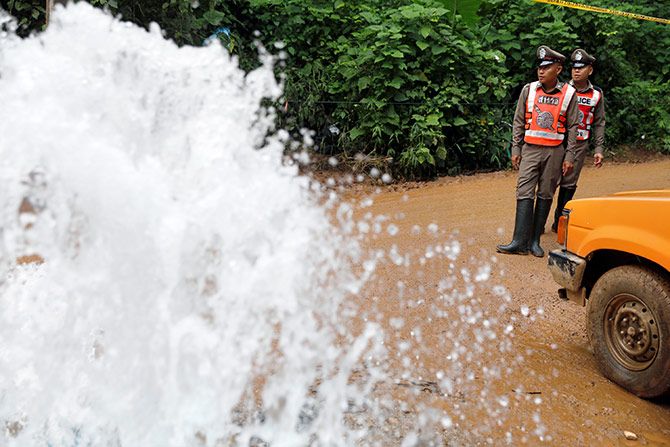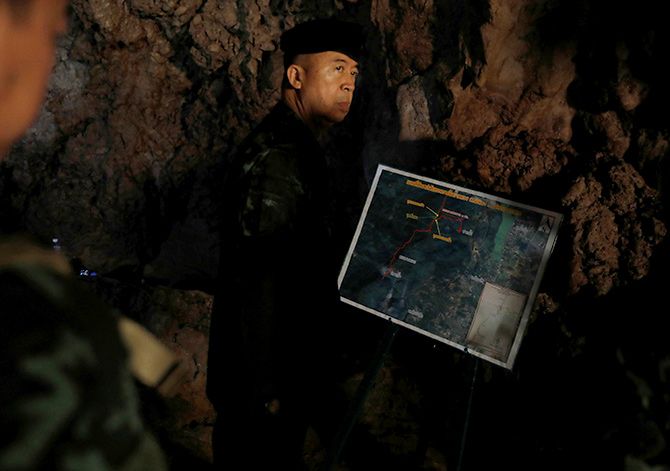In northern Thailand, hundreds of international rescue workers have been spending their last waking hours for the past 11 days trying to get a group of 12 boys, ages 11 to 16, and their 25-year-old soccer coach out who have been trapped in a cave after flooding caused by relentless monsoon rains.
On July 2, rescue teams discovered all of the boys and their coach alive and in relatively good health, sheltering deep inside the cave complex. Outside, family and friends, who had gathered, welcomed the news.
While the boys have been found, extracting them from the cave still remains a difficult task -- much of the return trip is underwater and even though pumps are lowering the water level, the rainfall is not letting up.
Here’s what’s happening and what officials are planning to get them out.

A Buddha statue is seen in front of the cave near Tham Luang cave complex, as an ongoing search for members of an under-16 soccer team and their coach continues, in the northern province of Chiang Rai, Thailand. The whole drama began on June 23 when the boys and the coach got trapped in the cave. They are believed to have entered the cave when it was dry, before sudden heavy rains blocked the exit. Photograph: Soe Zeya Tun/Reuters

Soldiers and rescue workers carry aid supplies to the Tham Luang cave complex. After being found trapped in the cave, authorities have been doing all they can to ensure that they are safe and are now racing against time to get them out. Supplies including food and water for at least two weeks along with aluminium blankets are being sent down inside the cave by Thai Navy and other divers. Photograph: Soe Zeya Tun/Reuters

Workers prepare to deliver small diving masks inside the Tham Luang Nang Non cave. As part of their rescue efforts, the divers are giving the boys and the coach rudimentary diving lessons. Authorities say diving through the murky water is currently the only way in and out. A fibre-optic cable was being laid inside the cave and would reach the boys soon, he added, so the children would be able to speak to and possibly see their parents on video. Photograph: Linh Pham/Getty Images

Soldiers and rescue workers carry a person role-playing as a victim on a stretcher during a drill, near the Tham Luang cave complex. Officials have been scouring the jungle above the complex to find new openings that could be drilled to extract the boys more easily. Photograph: Soe Zeya Tun/Reuters

Police stand guard near the Tham Luang cave complex as water gets pumped out from the cave. Huge volumes of water are being pumped out of the cave complex each day. Poonsak Woongsatngiem, a rescue official with Thailand’s interior ministry, was quoted as telling The Guardian that the water had been reduced by 40 per cent in the past days. However, more rainfall is putting pressure on rescuers to formulate a plan to remove the boys before flood waters rise any higher. Photograph: Soe Zeya Tun/Reuters

A helicopter transports heavy machinery that will be used to make a new entrance at the top of the cave. Hundreds of rescuers and equipment is being sent inside Tham Luang Nang Non cave to continue the rescue operation. Photograph: Soe Zeya Tun/Reuters

Divers working to free the 12 boys and their coach who are trapped in the cave must navigate dark, flooded tunnels for six hours to reach them. It takes another five hours to return. With wet weather looming, authorities are also calculating how long they are willing to allow rescuers to remain in the cave before they order an evacuation – one that could cut the boys off for up to four months. Photograph: Soe Zeya Tun/Reuters

Soldiers read a map in the Tham Luang caves. Rescue teams are working in extremely difficult conditions. The heat has been sweltering and unrelenting, at over 30C, while much of the site is submerged in squelchy mud that is several inches thick in places and extremely slippery. Photograph: Soe Zeya Tun/Reuters

As per the rescue plan, the boys would be dressed in wetsuits, boots and helmets, and divers would use an 8mm static rope to guide them out. They are likely to be provided with oxygen from a navy diver’s supply. A number of “stage tanks” have been put 25 to 50 metres along the cave system, so the boys can get to oxygen if needed. Divers working on the rescue have warned of the boys through the dark and dangerous waters still in the cave, especially since they are untrained. Photograph: Stringer/Reuters

New video released by the Thai Navy SEALs on Wednesday showed the boys wrapped in foil blankets for warmth, as they speak up one by one, introducing themselves and saying “I am healthy.” One said “thank you” to everyone who is waiting for their rescue. Photograph: Thai Navy Seal/Reuters

While the boys are for the most part physically healthy, experts say the ordeal has likely taken a mental toll that could worsen the longer the situation lasts. “It’s very likely that while the boys were in the cave but not yet discovered by rescuers that they experienced various degrees of anxiety, fear, confusion, vulnerability and dependency, and perhaps hopelessness,” said Paul Auerbach, of the Department of Emergency Medicine at Stanford University’s medical school. Photograph: Thai Navy Seal/Reuters

And while the boys wait, there is hope as one of the Chilean miners who was trapped underground for 69 days in 2010 is raising funds to travel to Thailand and help the rescue effort. Mario Sepulveda, was quoted by the AFP as saying, “Hang in there." Photograph: Thai Navy Seal/Reuters























 © 2025
© 2025